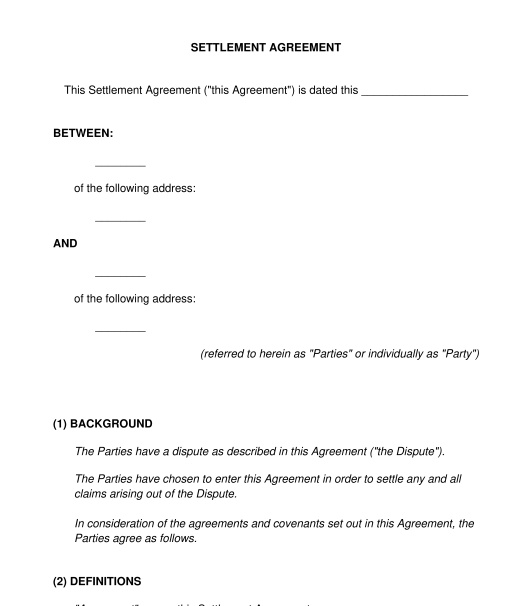 04/01/2025
04/01/2025

Answer a few questions and your document is created automatically.

Your document is ready! You will receive it in Word and PDF formats. You will be able to modify it.

 04/01/2025
04/01/2025
 Word and PDF
Word and PDF
 9 to 12 pages
9 to 12 pages
This Settlement Agreement is for use between two Parties to a dispute. The Parties may have been involved in mediation, conciliation, arbitration or litigation and may have reached an agreement about how the matter will be brought to an end. Once they have reached that agreement, they may use this Settlement Agreement to document what has been agreed, and what each Party must do.
This Settlement Agreement is a legally binding document that outlines the terms and conditions agreed upon by two or more Parties to resolve a dispute without the need for litigation. It can save time, money, and emotional stress, and provides a confidential and cost-effective way to resolve the proceedings. It also enables the Parties to design the outcome (as the Parties decide what is going to happen), rather than having a judge decide the outcome for them (as is the case with litigation).
This Agreement can be used for a variety of disputes, including employment disputes, contract disputes, and commercial disputes, claims relating to property damage and other similar matters. It may be used after the Parties have commenced any dispute resolution proceedings such as mediation, conciliation, arbitration or litigation (ie. court proceedings). This Agreement sets out all of the terms of the settlement, including payment of money, release of claims, and confidentiality.
In many cases, once the Parties agree to settle a dispute, they want to get it resolved as soon as possible. This Settlement Agreement provides a comprehensive and robust document so that both Parties fully understand what is expected of one another, and how the settlement arrangement may develop over time.
We have a variety of other documents that may be used at different stages of a dispute. For a general Deed of Release when two Parties are both releasing each other from certain obligations or liabilities (before legal proceedings have been commenced), consider using our Deed of Release (Mutual). For employment situations (when an employee is leaving the employer, and legal proceedings have not been commenced), we have a Deed of Release for Employment available. If the release is only going one way - if one party (the "First Party") is releasing the other party (the "Second Party"), but the Second Party is not releasing the First Party, we have a Deed of Release (General One Way) available.
Once the Parties enter this Agreement, the dispute between them will be finalised, meaning that neither Party can take any further action in relation to the dispute (unless the other Party does not comply with this Agreement or the proceedings are otherwise reinstated in accordance with this Agreement). This means that the Parties may be giving up some of their legal rights. Therefore, if the Parties have any concerns about this, they should seek legal advice.
This Settlement Agreement can be used by Parties that wish to resolve a dispute that is underway. The Parties should negotiate the terms of the Agreement until they reach a mutually acceptable resolution.
Often, one Party might propose a resolution to the other Party. They might do this by using a Settlement Offer document.
Within the Agreement, the Parties may enter the following information:
This should not be done without careful consideration. Both Parties should make sure that they understand the consequences of this. If they have any doubt, they should seek independent legal advice. Because of this, the Agreement also includes a clause confirming that the Parties have had the opportunity to obtain legal advice (and either took that advice, or chose not to obtain advice). If either Party has not had the opportunity to obtain legal advice, then they should not sign the Agreement.
Once the Parties have agreed to the terms of the settlement, they should sign the Agreement and keep a copy for their own records.
In some cases, particularly if court proceedings are underway, the Parties may also need to provide a copy to the court.
This Settlement Agreement is intended for use in Australia and is governed by Australian law. Parties should seek legal advice before entering into a settlement agreement to ensure that it meets their specific needs and is enforceable under applicable law.
If this Agreement is being used by the Parties to release each other from certain contractual obligations, then general principles of contract law, as provided by the common law, may apply.
In addition, if the Agreement is being used by the Parties to release each other from other legal obligations, for example, in connection with damage to property or personal injuries, then various other bodies of law may apply. For example, each state and territory has legislation and common law that deals with civil liability, and which may need to be considered. The Settlement Agreement may also need to comply with any relevant laws or regulations that apply to the subject matter of the dispute, such as consumer protection laws, employment laws, or intellectual property laws. If litigation is underway then the Parties may also need to consider court rules as well as civil procedure laws and regulations for the relevant court and jurisdiction.
In addition, the Corporations Act 2001 (Cth) deals with the signing of agreements by companies.
If in doubt, seek legal advice.
You fill out a form. The document is created before your eyes as you respond to the questions.
At the end, you receive it in Word and PDF formats. You can modify it and reuse it.
A guide to help you: What to do after Preparing a Contract
Settlement Agreement - sample template - Word and PDF
Country: Australia